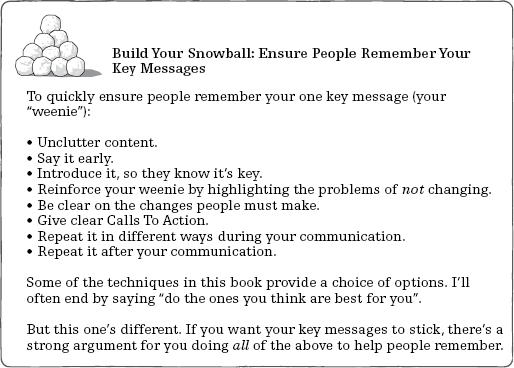Walt Disney used to say that his theme parks needed a “weenie” – iconic landmarks to draw visitors in – like Cinderella’s Castle at the Magic Kingdom, or the Tree of Life at Animal Kingdom (“weenies” being the sizzling sausages that entice you towards a hotdog stand). If you’ve been to any Disney park, you’ll know how eye-catching their weenies are.
Similarly, when you’re communicating, you’ll sometimes have one key message – your weenie – you want people to hear and act on. You want it to stand out amongst all your other messages, so it causes an instant, dramatic, and lasting impact on everyone who hears it.
1. Unclutter content: Strip out everything you can, apart from your weenie. You’ll have plenty of other opportunities to mention them.
2. Say it early: People’s concentration dips during a communication, so say your weenie early. Then continually reinforce it. Don’t build up to saying it at the end, as your audience might have switched off by then.
3. Introduce it, so they know it’s key: Use “definite” words to introduce it, so they know it’s important: “There’s only one thing I want you to focus on this year, which is . . . ”.
4. Reinforce your weenie, by highlighting the problems of not changing: Say what you don’t want people to do: “If we don’t change and keep doing X, Y will happen”.
5. Be clear on the changes people must make: If your weenie means people have to act differently, say so. To ensure they understand what they’re changing from and to, start by referring to what they do now: “Whereas you’re currently doing X, I now want you to do Y instead”.
6. Give crystal clear Calls To Action (maybe using “for instance”): You want to eliminate the chances of people
not doing what you want. For example, if your weenie/key message was “please enhance our reputation”, even if everyone remembered the message, they wouldn’t necessarily know what to do about it.
Using “for instance” makes it much easier for them: “So, going forward, I want you to enhance our division’s reputation within the company.
For instance, you could:
- Call your key contacts, and ask how we can help them more.
- Think what’s been well received in the past, and do it again.
- Ask colleagues how they’ve enhanced their reputation, and copy it.
- Identify other divisions that impress you, and learn from them”.
7. Repeat your weenie during your communication: There’s lots of research discussing how often people need to hear something before it sticks. Recommendations vary, but they all agree people need to hear things more than once.
So, repeat your weenie. Say it in different ways. Enhance it with examples, stories, visuals, analogies, and the like.
8. Repeat your weenie after your communication: Use follow-up communications to reinforce your key message. Ask your managers to mention it in all their team meetings. Give the “unofficial leaders” – the ones you need to get on side when you want to change things – the responsibility and motivation to keep mentioning it for you.
When you have one weenie, do all you can to get your message across (if you’ve more than one message, the next chapter shows you how to communicate them all). The key thing to remember is your audience has lots on their minds, not just your weenie. So help make it impossible for them to forget.


